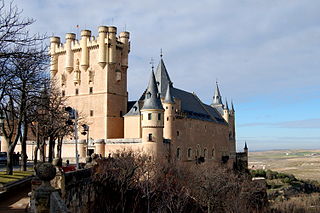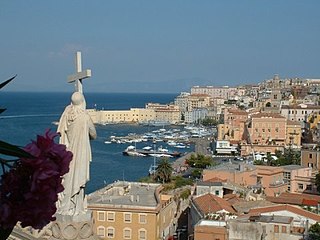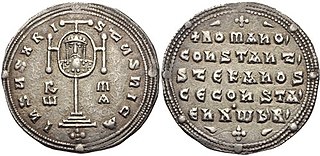John I (died 933 or 934) was the second hypatus of Gaeta of his dynasty, a son of Dociblis I and Matrona, and perhaps the greatest of medieval Gaetan rulers.

Docibilis I was the Hypatus of Gaeta from 867 until his death.
He began his rule as an associate of his father from either 867, right after his father's violent takeover, or 877, when he is first mentioned as co-regent. In that year he received the honorific patrikios from Byzantine Emperor Constantine VII. His father disappears from the annals in 906, but he is only confirmed dead in 914. Nonetheless, the intervening period was John's. He recognised his brother Anatolio as duke of Terracina and sold the castle of Dragoncello to his other brothers. He began to reverse the policy of his father of alliance with the Saracens and war with his Lombard and Greek neighbours. He married his daughters off strategically: Gemma to the Sorrentine prefect Marinus, Maru to the Salernitan nobleman Guaifer, and Matrona to Campolo, of an important Gaetan family. Probably from the earliest, in 906, John associated his own son Docibilis in a co-regency, certainly by 914.

Constantine VII Porphyrogennetos or Porphyrogenitus was the fourth Emperor of the Macedonian dynasty of the Byzantine Empire, reigning from 913 to 959. He was the son of the emperor Leo VI and his fourth wife, Zoe Karbonopsina, and the nephew of his predecessor, the emperor Alexander.

Terracina is a city and comune of the province of Latina -, Italy, 76 kilometres southeast of Rome by rail and 56 kilometres (35 mi) by the Via Appia by car.

A castle is a type of fortified structure built during the Middle Ages by predominantly the nobility or royalty and by military orders. Scholars debate the scope of the word castle, but usually consider it to be the private fortified residence of a lord or noble. This is distinct from a palace, which is not fortified; from a fortress, which was not always a residence for royalty or nobility; and from a fortified settlement, which was a public defence – though there are many similarities among these types of construction. Usage of the term has varied over time and has been applied to structures as diverse as hill forts and country houses. Over the approximately 900 years that castles were built, they took on a great many forms with many different features, although some, such as curtain walls and arrowslits, were commonplace.
Together, father and son joined the Byzantine strategos Nicholas Picingli's army marching with its Lombard allies to meet the papal and Spoletan forces. All together, the Christian league attacked the Moslems of the Garigliano and, in the subsequent battle, the Gaetan hypati distinguished themselves in victory. The Gaetan territory was extended to the Garigliano River. John continued construction on the palace his father had begun and he associated his grandson, John II, with him in 933. He died within the year and left three other sons (Leo, Constantine, and Peter), but Docibilis, who had taken the ducal title in 930, inherited alone and did not divide the realm. Thus, John is the last ruler of Gaeta who was not a duke.

Strategos or Strategus, plural strategoi, is used in Greek to mean military general. In the Hellenistic world and the Byzantine Empire the term was also used to describe a military governor. In the modern Hellenic Army it is the highest officer rank.
Nicholas Epigingles, better known by his Latinized surname Picingli, was a Byzantine general active in southern Italy and the Balkans. As strategos of the thema of Longobardia, he led the Byzantine contingent of the Christian league in the Battle of Garigliano in 915. He was killed fighting against the Bulgarians, probably in the Battle of Acheloos on 20 August 917.

Spoleto is an ancient city in the Italian province of Perugia in east-central Umbria on a foothill of the Apennines. It is 20 km (12 mi) S. of Trevi, 29 km (18 mi) N. of Terni, 63 km (39 mi) SE of Perugia; 212 km (132 mi) SE of Florence; and 126 km (78 mi) N of Rome.

Gaeta is a city and comune in the province of Latina, in Lazio, central Italy. Set on a promontory stretching towards the Gulf of Gaeta, it is 120 kilometres from Rome and 80 km (50 mi) from Naples.
The Battle of Garigliano was fought in 915 between Christian forces and the Saracens. Pope John X personally led the Christian forces into battle. The aim was to destroy the Arab fortress on the Garigliano river, which had threatened central Italy and the outskirts of Rome for nearly 30 years.

The Duchy of Gaeta was an early medieval state centered on the coastal South Italian city of Gaeta. It began in the early ninth century as the local community began to grow autonomous as Byzantine power lagged in the Mediterranean and the peninsula due to Lombard and Saracen incursions.
Guaimar III was the Lombard prince of Salerno from around 994 to his death. Under his reign, Salerno entered an era of great splendour. Opulenta Salernum was the inscription on his coins. He made Amalfi, Gaeta and Sorrento his vassals and annexed much of Byzantine Apulia and Calabria.
Docibilis II was the ruler of Gaeta, in one capacity or another, from 906 until his death. He was the son of the hypatus John I, who made him co-ruler in 906 or thereabouts.
John II was the duke of Gaeta, associated with his father Docibilis II and grandfather John I from 933 and sole ruler from the former's death in 954. His mother was Orania, of Neapolitan extraction. In 934, he was ruling alone with his father, his grandfather having died in the interim.
Landulf I, sometimes called Antipater, was a Lombard nobleman and the Prince of Benevento and of Capua from 12 January 901, when his father, Atenulf I, prince of Capua and conqueror of Benevento, associated his with him in power.
Landulf II, called the Red, was the Lombard prince of Benevento and prince of Capua from 939 or 940, when his father, Landulf I, first associated him with the government. His mother was Gemma, daughter of Athanasius of Naples. He may have been associated as early as 933, when his elder brother, Atenulf III, was made co-regent. His uncle Atenulf II died in 940 and it is likely that Landulf served as a replacement. Landulf married Yvantia on an unknown date.
Alberic I was the Lombard duke of Spoleto from between 896 and 900 until 920, 922, or thereabouts. He was also Margrave of Camerino, and the son-in-law of Theophylact of Tusculum, the most powerful man in Rome.
Emilia was the duchess of Gaeta first as consort of John III (984–1008) and then as the regent for her grandson John V (1012–1032) until at least 1029.
Leo I, sometimes called the Usurper, was the regent of the Duchy of Gaeta from 1017 until 1024. He was a younger son of Duke John III and Duchess Emilia. After the death of his brother, John IV in 1008, his mother took over the regency for her grandson, Leo's nephew, John V. Leo challenged his mother for the regency, successfully displacing her by 1017.
Leo II was the Duke of Gaeta briefly in early 1042. He was the last duke of the native Docibilan family. His father was the magnificus Docibilis, a grandson of Duke Gregory. His brother, Hugh, was the count of Suio.
The Principality of Capua was a Lombard state centred on Capua in Southern Italy, usually de facto independent, but under the varying suzerainty of Western and Eastern Roman Empires. It was originally a gastaldate, then a county, within the principality of Salerno.
John III was the consul and duke of Gaeta from some time between October 984 and January 986 until his death.
Pandenulf was the Count of Capua, claiming that title from 862 and holding it successfully during the tumultuous civil war of 879 – 882. He was the son and successor of Pando, but was removed on his father's death by his uncle the bishop, Landulf II.
The 1020s was a decade of the Julian Calendar which began on January 1, 1020, and ended on December 31, 1029.

Stephen Lekapenos or Lecapenus was the second son of the Byzantine emperor Romanos I Lekapenos, and co-emperor from 924 to 945. With his younger brother Constantine, he deposed Romanos I in December 944, but was overthrown and exiled by the legitimate emperor Constantine VII a few weeks later. Stephen lived out his life in exile on the island of Lesbos, where he died on Easter 963.








